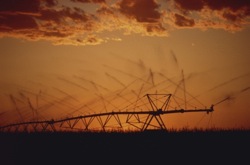 Almost everywhere you look this week, California is dry. By which we mean the state is experiencing the first truly warm, rainless week since a series of Pacific storms blew through the state in mid-January.
Almost everywhere you look this week, California is dry. By which we mean the state is experiencing the first truly warm, rainless week since a series of Pacific storms blew through the state in mid-January.
Hydrologists for the state Department of Water Resources and the federal California-Nevada River Forecast Center expect the warm temperatures to trigger the first significant surge of snowmelt for the season. With slightly above-average snowpacks in the Sierra Nevada, that should help continue to raise reservoir levels. Our 2009-2010 rainy season is likely to go down in water history as adequate–short of hopes for a wet year but an improvement on the past three winters, which were much drier than average.
Admittedly, that’s the view from the city, where we get our water out of taps and garden hoses. The picture for agricultural users is not nearly as bright, as we were reminded earlier this week.
On Tuesday, the U.S. Bureau of Reclamation issued an updated allocation for its customers in the Central Valley. The bureau offered a good news-bad news scenario. For CVP customers north of the Sacramento-San Joaquin Delta, the news was mostly good. Agricultural contractors there will get at least 50% of promised deliveries this year; municipal and industrial customers will get 75%. South of the Delta, the news is not so good. Municipal and industrial users will get 75%, but farm customers are guaranteed just a quarter of the water they want.
That 25% zone south of the Delta includes the Westlands Water District and other areas on the west side of the San Joaquin Delta that have suffered severe water shortages, due mostly to the state’s prolonged dry spell and, less directly, to restrictions imposed on Delta pumping to protect Delta smelt and Chinook salmon.
That’s the same area for which Sen. Dianne Feinstein tried to secure extra water this year–even if it meant overriding provisions of the Endangered Species Act. Feinstein’s effort to attach a water amendment to a federal jobs bill failed, but the move apparently prodded the Department of the Interior–the parent agency of the Bureau of Reclamation–to try to find more water for Westlands and its neighbors. This week’s allocation announcement included assurances that the department is still working to secure additional water for west side farmers.
The state Department of Water Resources, which also ships water from the Delta to customers in the San Joaquin Valley and beyond via the California Aqueduct, also issued an updated allocation announcement this week. The department said that for now it’s sticking with its guarantee of 15 percent of requested deliveries this year.
Why such a low figure? The department says it’s because of continuing “poor hydrological conditions” in the Feather River drainage that feeds the State Water Project’s principal reservoir, Lake Oroville. The main symptom of those conditions is the lake’s storage level, now just 57% of average for mid-March. For contrast, look at California’s main federal reservoir, Lake Shasta, less than 100 miles away from Oroville as the crow flies. It’s got 104% of average storage for the date (not to be confused with percent of capacity).
Here’s my amateur, off-the-cuff runoff-watcher’s observation of what’s behind the difference: The Shasta drainage, which captures the upper reaches of the Sacramento, McCloud and Pit rivers as well as lesser streams, has benefited from several storms since mid-January that dumped heavy rains throughout the watershed. Those same storms have dropped lighter amounts of rain further south and east, including over the Feather watershed. The same effect can be seen in the American River basin, which flows into Folsom Lake. A month or so of intense precipitation last year eventually filled the lake; lighter rains this year have led to lower-than-average storage levels in Folsom (84 percent as of this week).
The final word on the water season, of course, will come from the Sierra snowpack and runoff. Stay tuned for the snow melt.
Check recent levels of California’s major reservoirs on the map, below:
View KQED: California Reservoir Watch in a larger map
